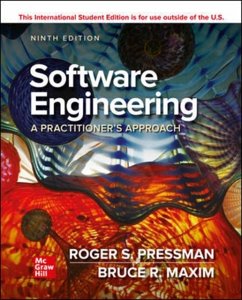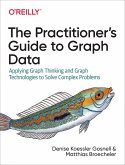- Broschiertes Buch
- Merkliste
- Auf die Merkliste
- Bewerten Bewerten
- Teilen
- Produkt teilen
- Produkterinnerung
- Produkterinnerung
For almost four decades, Software Engineering: A Practitioner's Approach (SEPA) has been the world's leading textbook in software engineering. The ninth edition represents a major restructuring and update of previous editions, solidifying the book's position as the most comprehensive guide to this important subject.
Andere Kunden interessierten sich auch für
![The Complete Practitioner's Guide to the Bond Market (Pb) The Complete Practitioner's Guide to the Bond Market (Pb)]() Steven DymThe Complete Practitioner's Guide to the Bond Market (Pb)83,99 €
Steven DymThe Complete Practitioner's Guide to the Bond Market (Pb)83,99 €![Energy Systems Engineering: Evaluation and Implementation, Fourth Edition Energy Systems Engineering: Evaluation and Implementation, Fourth Edition]() Francis VanekEnergy Systems Engineering: Evaluation and Implementation, Fourth Edition149,99 €
Francis VanekEnergy Systems Engineering: Evaluation and Implementation, Fourth Edition149,99 €![Ethics in Civil and Structural Engineering: Professional Responsibility and Standard of Care Ethics in Civil and Structural Engineering: Professional Responsibility and Standard of Care]() Dave AdamsEthics in Civil and Structural Engineering: Professional Responsibility and Standard of Care98,99 €
Dave AdamsEthics in Civil and Structural Engineering: Professional Responsibility and Standard of Care98,99 €![Water and Wastewater Engineering: Design Principles and Practice, Second Edition Water and Wastewater Engineering: Design Principles and Practice, Second Edition]() Mackenzie DavisWater and Wastewater Engineering: Design Principles and Practice, Second Edition128,99 €
Mackenzie DavisWater and Wastewater Engineering: Design Principles and Practice, Second Edition128,99 €![Modern Software Engineering: Doing What Works to Build Better Software Faster Modern Software Engineering: Doing What Works to Build Better Software Faster]() David FarleyModern Software Engineering: Doing What Works to Build Better Software Faster29,99 €
David FarleyModern Software Engineering: Doing What Works to Build Better Software Faster29,99 €![The Practitioner's Guide to Graph Data The Practitioner's Guide to Graph Data]() Denise GosnellThe Practitioner's Guide to Graph Data57,99 €
Denise GosnellThe Practitioner's Guide to Graph Data57,99 €![Fascial Manipulation(r) - Stecco(r) Method the Practitioner's Perspective Fascial Manipulation(r) - Stecco(r) Method the Practitioner's Perspective]() Julie Ann DayFascial Manipulation(r) - Stecco(r) Method the Practitioner's Perspective54,99 €
Julie Ann DayFascial Manipulation(r) - Stecco(r) Method the Practitioner's Perspective54,99 €-
-
-
For almost four decades, Software Engineering: A Practitioner's Approach (SEPA) has been the world's leading textbook in software engineering. The ninth edition represents a major restructuring and update of previous editions, solidifying the book's position as the most comprehensive guide to this important subject.
Produktdetails
- Produktdetails
- Verlag: McGraw-Hill Education
- 9 ed
- Seitenzahl: 1408
- Erscheinungstermin: 30. September 2019
- Englisch
- Abmessung: 221mm x 169mm x 23mm
- Gewicht: 1094g
- ISBN-13: 9781260548006
- ISBN-10: 1260548007
- Artikelnr.: 58052544
- Herstellerkennzeichnung
- Libri GmbH
- Europaallee 1
- 36244 Bad Hersfeld
- gpsr@libri.de
- Verlag: McGraw-Hill Education
- 9 ed
- Seitenzahl: 1408
- Erscheinungstermin: 30. September 2019
- Englisch
- Abmessung: 221mm x 169mm x 23mm
- Gewicht: 1094g
- ISBN-13: 9781260548006
- ISBN-10: 1260548007
- Artikelnr.: 58052544
- Herstellerkennzeichnung
- Libri GmbH
- Europaallee 1
- 36244 Bad Hersfeld
- gpsr@libri.de
Roger S. Pressman is an internationally recognized authority on software process improvement and software engineering technologies. He was president of R. S. Pressman and Associates Inc., a consultancy specializing in software engineering and is also the founder and chief technology officer of EVANNEX®, an automotive aftermarket company that specializes in the design and manufacture of accessories for the Tesla line of electric vehicles.
1) Software and Software Engineering
Part One - The Software Process
2) Process Models
3) Agility and Process
4) Recommended Process Model
5) Human Aspects of Software Engineering
Part Two - Modeling
6) Principles That Guide Practice
7) Understanding Requirements
8) Requirements Modeling - A Recommended Approach
9) Design Concepts
10) Architectural Design - A Recommended Approach
11) Component-Level Design
12) User Experience Design
13) Design for Mobility
14) Pattern-Based Design
Part Three - Quality and Security
15) Quality Concepts
16) Reviews - A Recommended Approach
17) Software Quality Assurance
18) Software Security Engineering
19) Software Testing - Component Level
20) Software Testing - Integration Level
21) Software Testing - Specialized Testing for Mobility
22) Software Configuration Management
23) Software Metrics and Analytics
Part Four - Managing Software Projects
24) Project Management Concepts
25) Creating a Viable Software Plan
26) Risk Management
27) A Strategy for Software Support
Part Five - Advanced Topics
28) Software Process Improvement
29) Emerging Trends in Software Engineering
30) Concluding Comments
Appendix I - An Introduction to UML
Appendix II - Data Science for Software Engineers
Part One - The Software Process
2) Process Models
3) Agility and Process
4) Recommended Process Model
5) Human Aspects of Software Engineering
Part Two - Modeling
6) Principles That Guide Practice
7) Understanding Requirements
8) Requirements Modeling - A Recommended Approach
9) Design Concepts
10) Architectural Design - A Recommended Approach
11) Component-Level Design
12) User Experience Design
13) Design for Mobility
14) Pattern-Based Design
Part Three - Quality and Security
15) Quality Concepts
16) Reviews - A Recommended Approach
17) Software Quality Assurance
18) Software Security Engineering
19) Software Testing - Component Level
20) Software Testing - Integration Level
21) Software Testing - Specialized Testing for Mobility
22) Software Configuration Management
23) Software Metrics and Analytics
Part Four - Managing Software Projects
24) Project Management Concepts
25) Creating a Viable Software Plan
26) Risk Management
27) A Strategy for Software Support
Part Five - Advanced Topics
28) Software Process Improvement
29) Emerging Trends in Software Engineering
30) Concluding Comments
Appendix I - An Introduction to UML
Appendix II - Data Science for Software Engineers
1) Software and Software Engineering
Part One - The Software Process
2) Process Models
3) Agility and Process
4) Recommended Process Model
5) Human Aspects of Software Engineering
Part Two - Modeling
6) Principles That Guide Practice
7) Understanding Requirements
8) Requirements Modeling - A Recommended Approach
9) Design Concepts
10) Architectural Design - A Recommended Approach
11) Component-Level Design
12) User Experience Design
13) Design for Mobility
14) Pattern-Based Design
Part Three - Quality and Security
15) Quality Concepts
16) Reviews - A Recommended Approach
17) Software Quality Assurance
18) Software Security Engineering
19) Software Testing - Component Level
20) Software Testing - Integration Level
21) Software Testing - Specialized Testing for Mobility
22) Software Configuration Management
23) Software Metrics and Analytics
Part Four - Managing Software Projects
24) Project Management Concepts
25) Creating a Viable Software Plan
26) Risk Management
27) A Strategy for Software Support
Part Five - Advanced Topics
28) Software Process Improvement
29) Emerging Trends in Software Engineering
30) Concluding Comments
Appendix I - An Introduction to UML
Appendix II - Data Science for Software Engineers
Part One - The Software Process
2) Process Models
3) Agility and Process
4) Recommended Process Model
5) Human Aspects of Software Engineering
Part Two - Modeling
6) Principles That Guide Practice
7) Understanding Requirements
8) Requirements Modeling - A Recommended Approach
9) Design Concepts
10) Architectural Design - A Recommended Approach
11) Component-Level Design
12) User Experience Design
13) Design for Mobility
14) Pattern-Based Design
Part Three - Quality and Security
15) Quality Concepts
16) Reviews - A Recommended Approach
17) Software Quality Assurance
18) Software Security Engineering
19) Software Testing - Component Level
20) Software Testing - Integration Level
21) Software Testing - Specialized Testing for Mobility
22) Software Configuration Management
23) Software Metrics and Analytics
Part Four - Managing Software Projects
24) Project Management Concepts
25) Creating a Viable Software Plan
26) Risk Management
27) A Strategy for Software Support
Part Five - Advanced Topics
28) Software Process Improvement
29) Emerging Trends in Software Engineering
30) Concluding Comments
Appendix I - An Introduction to UML
Appendix II - Data Science for Software Engineers








